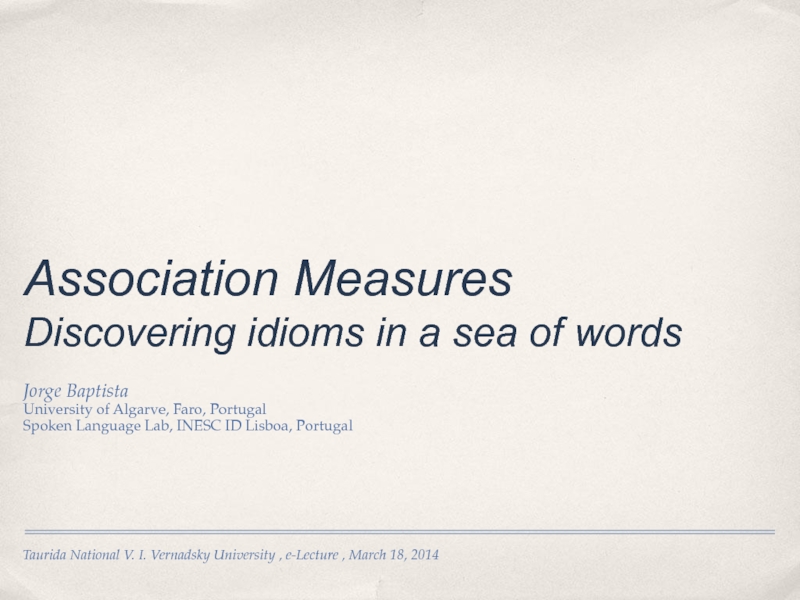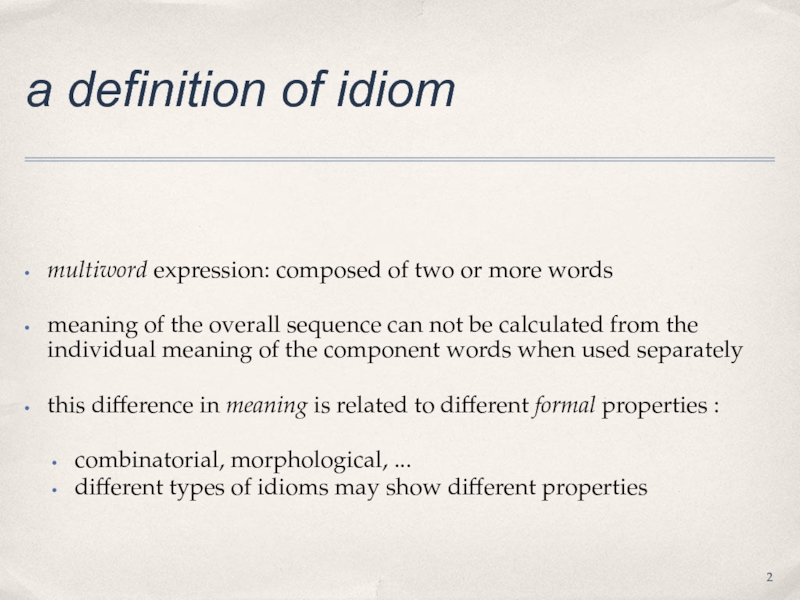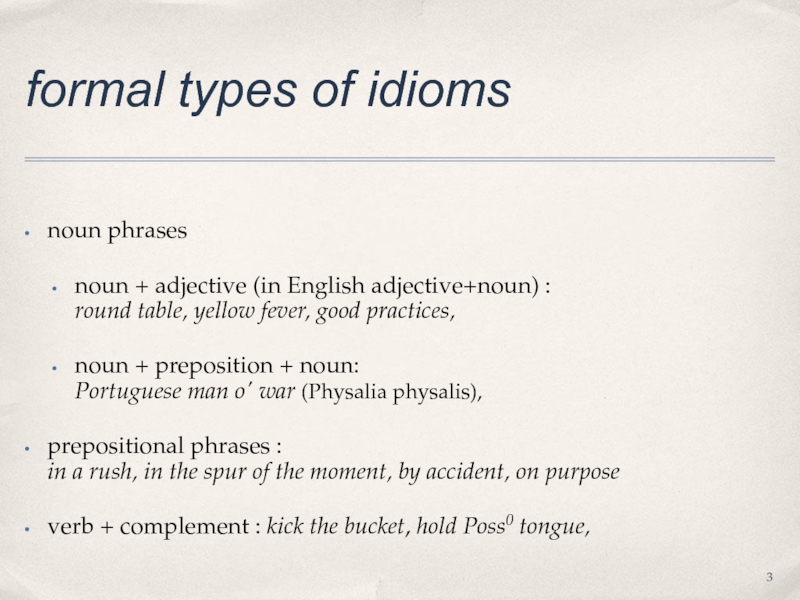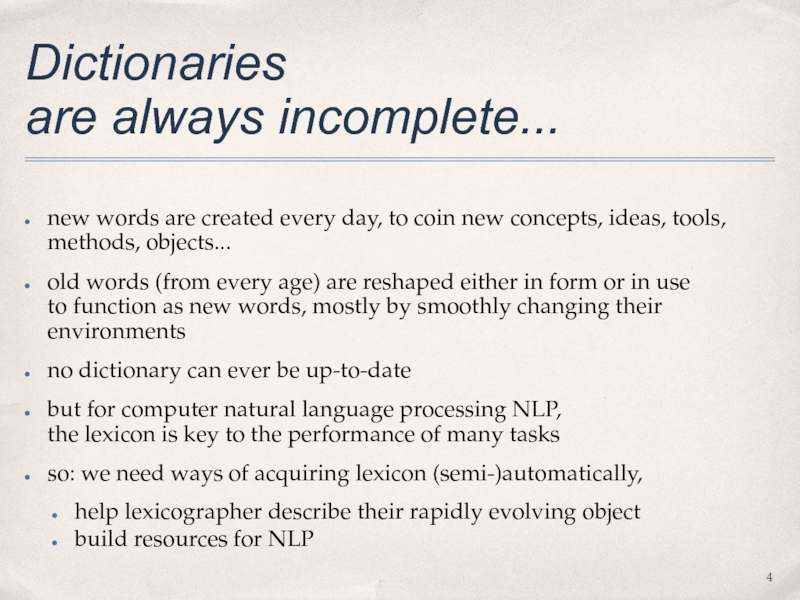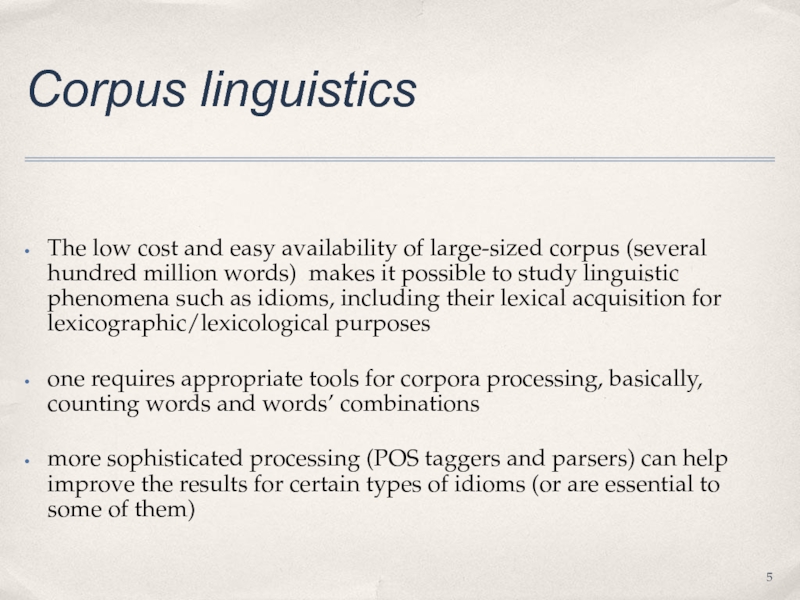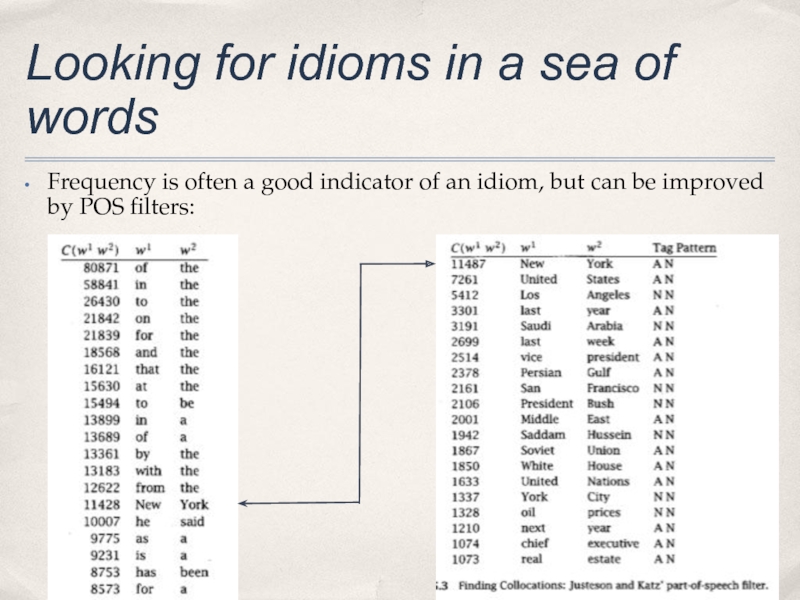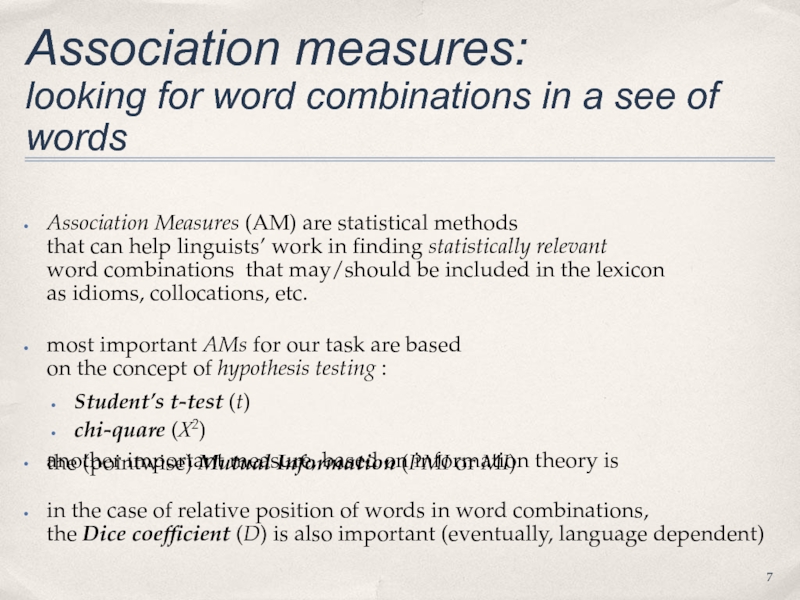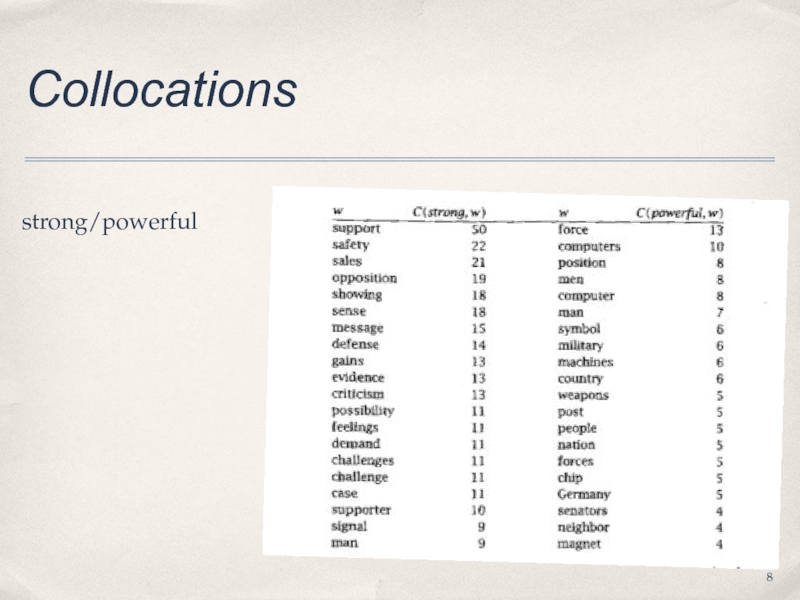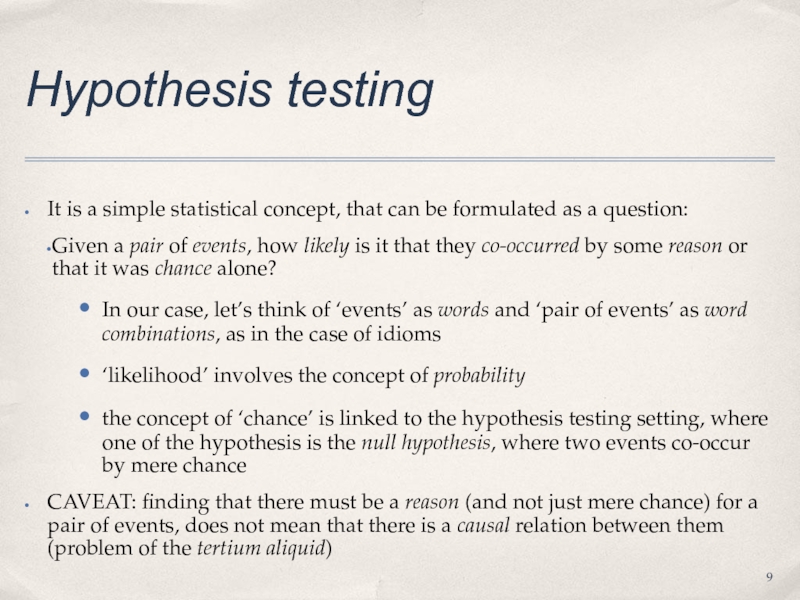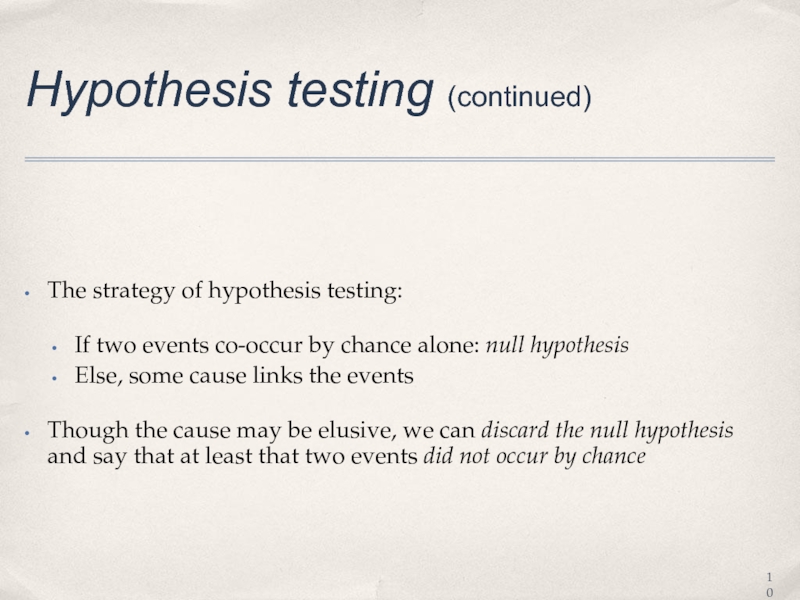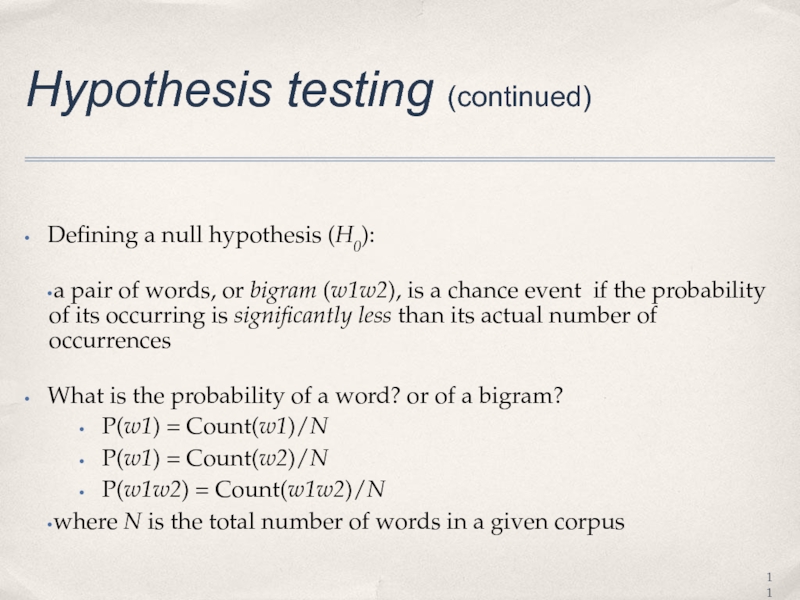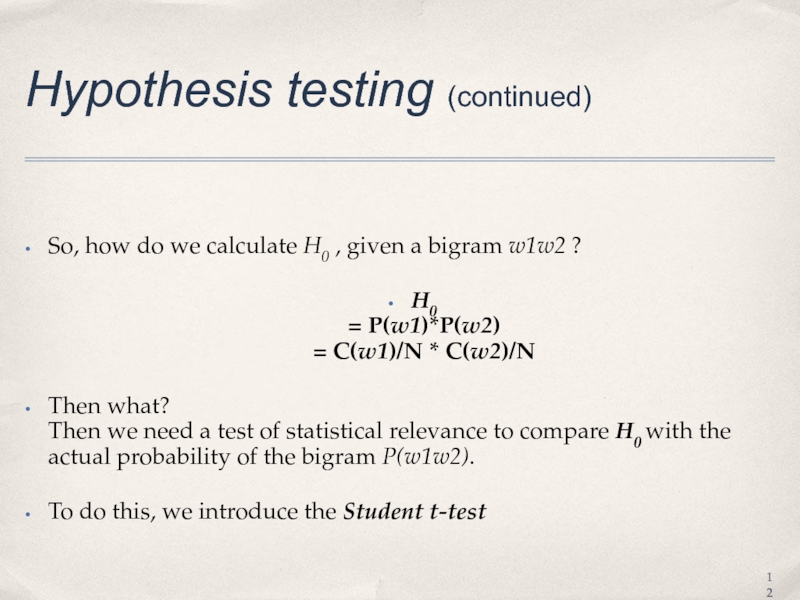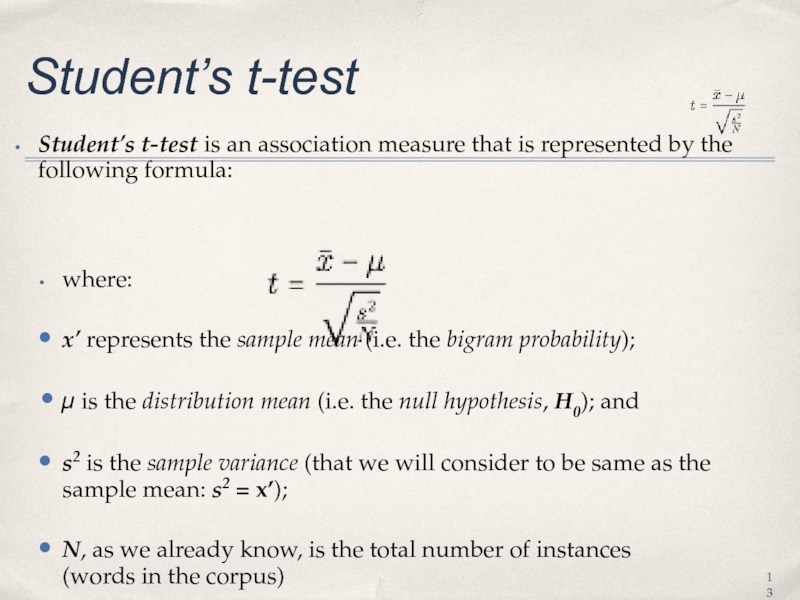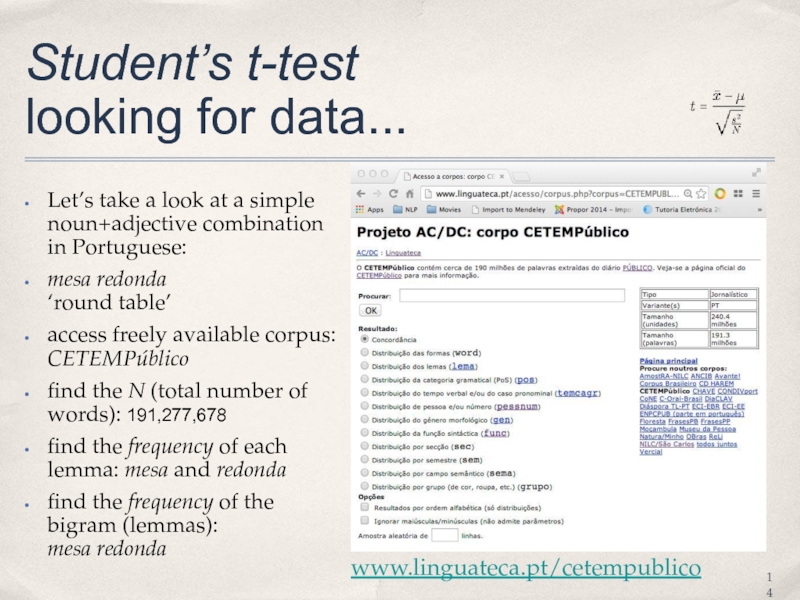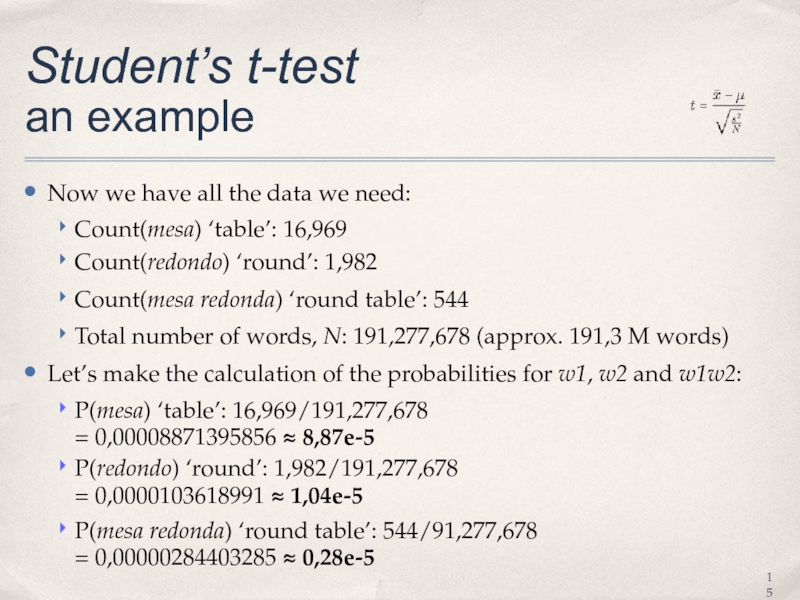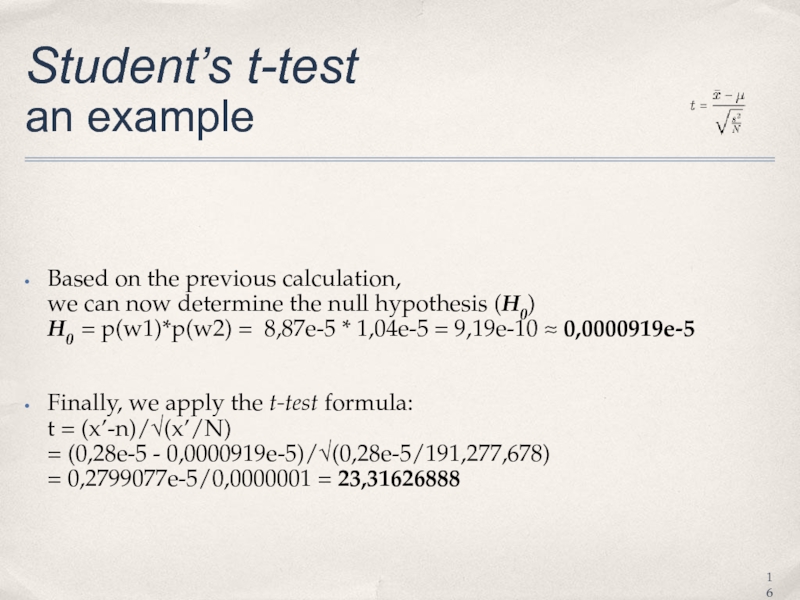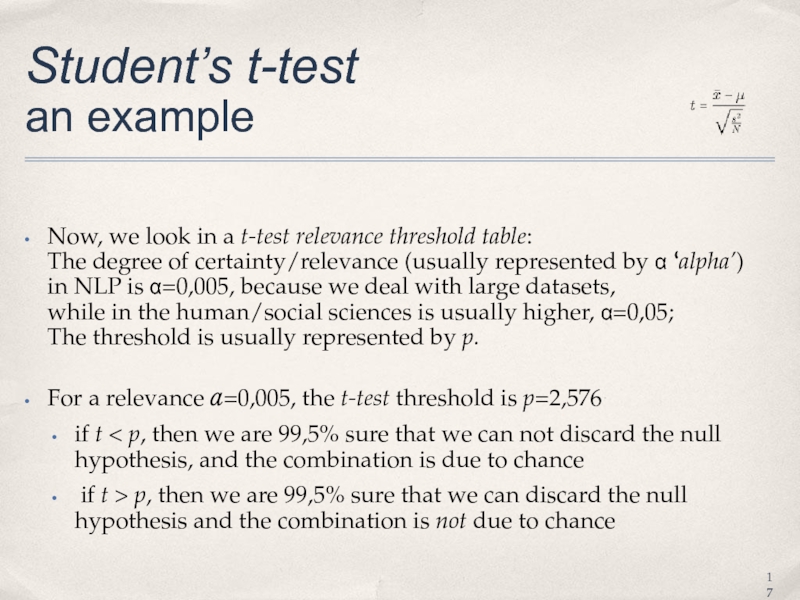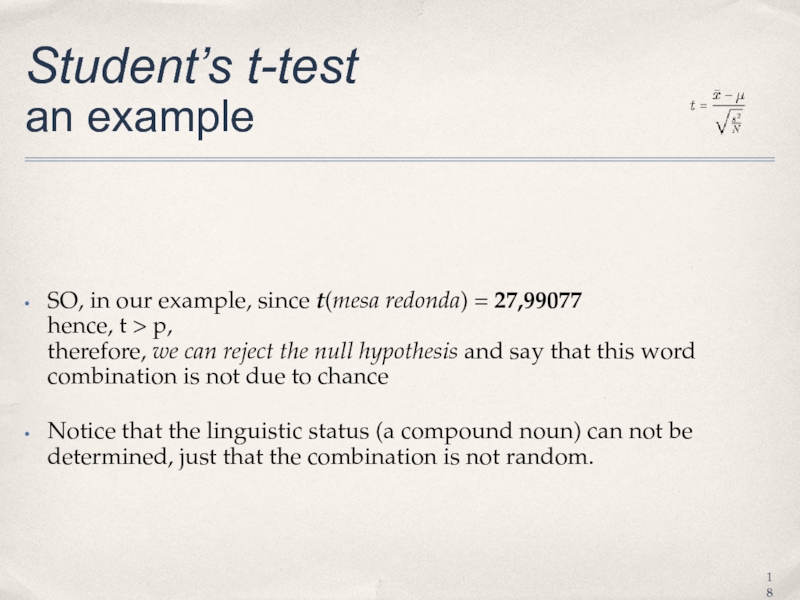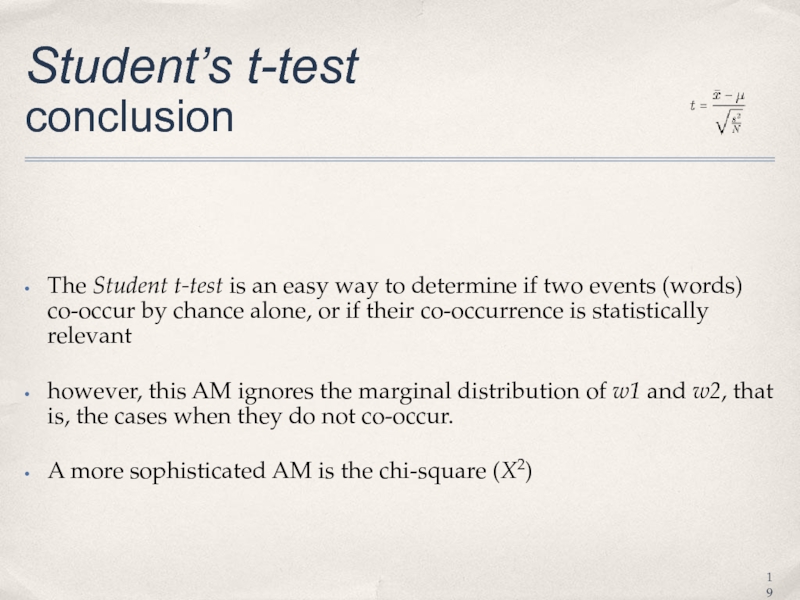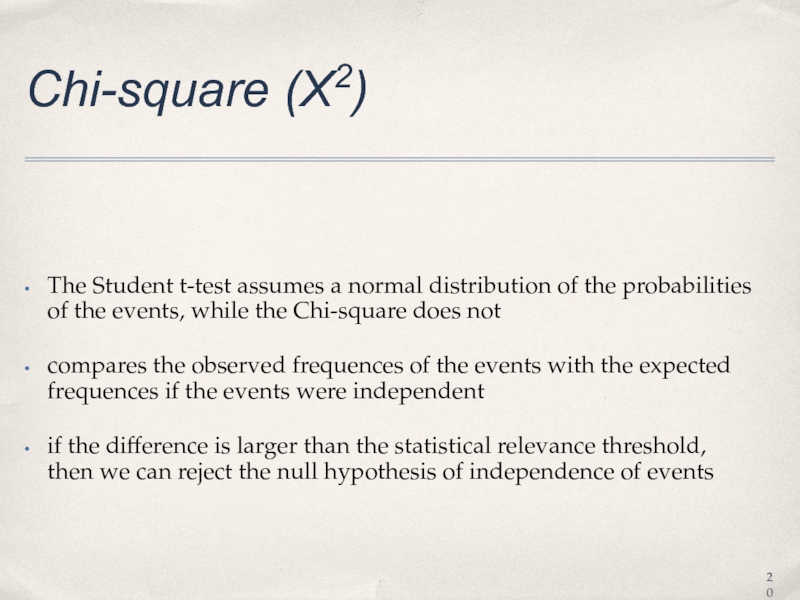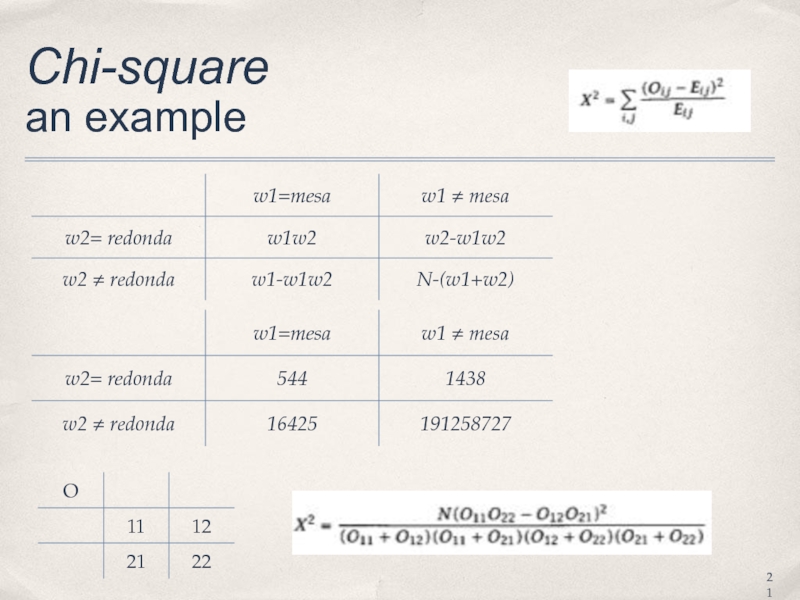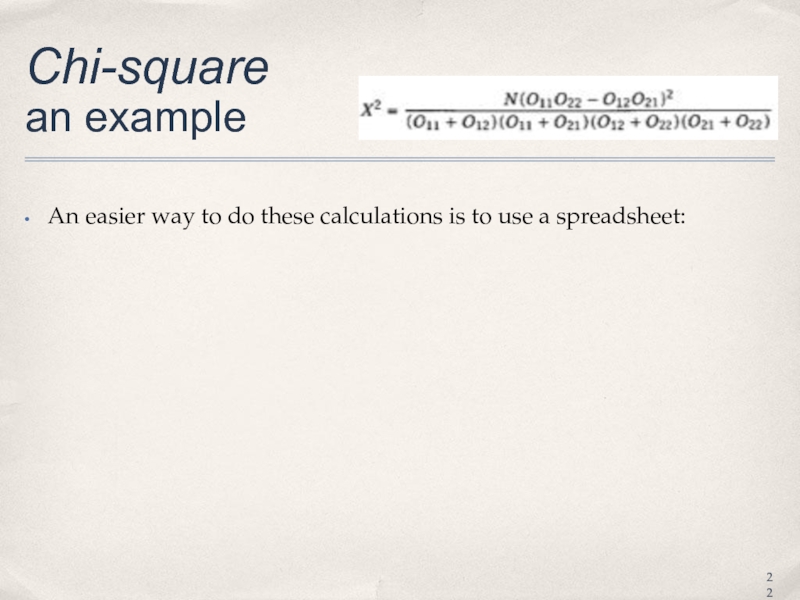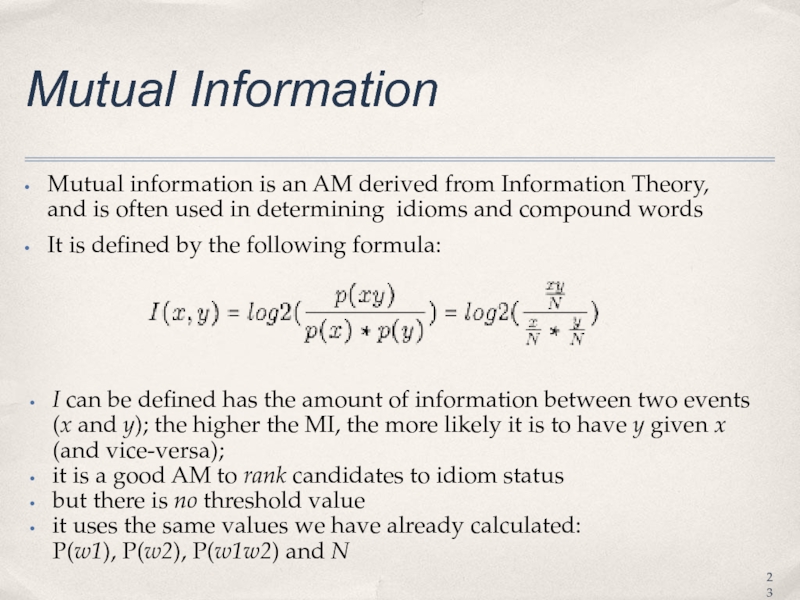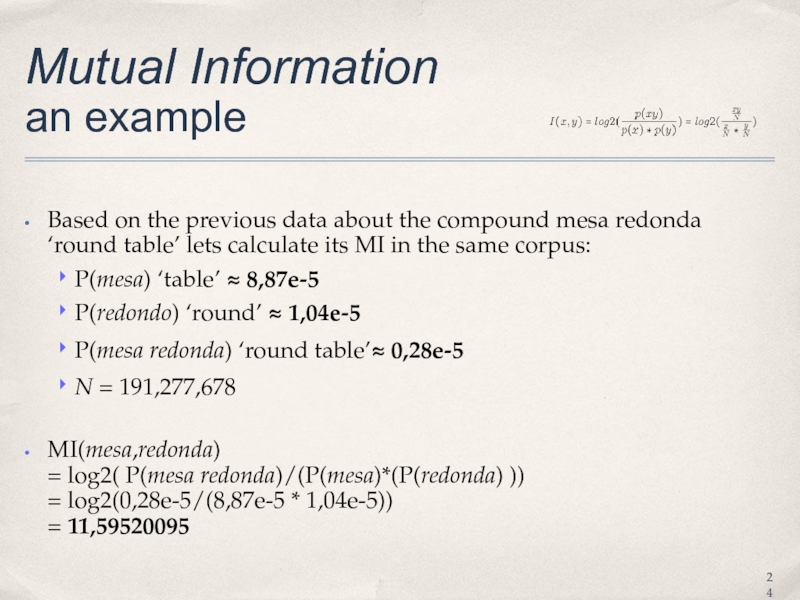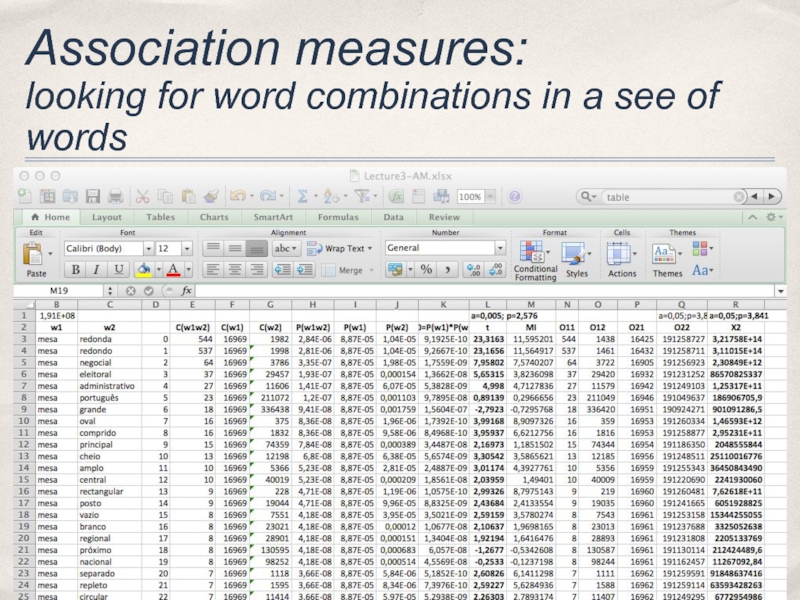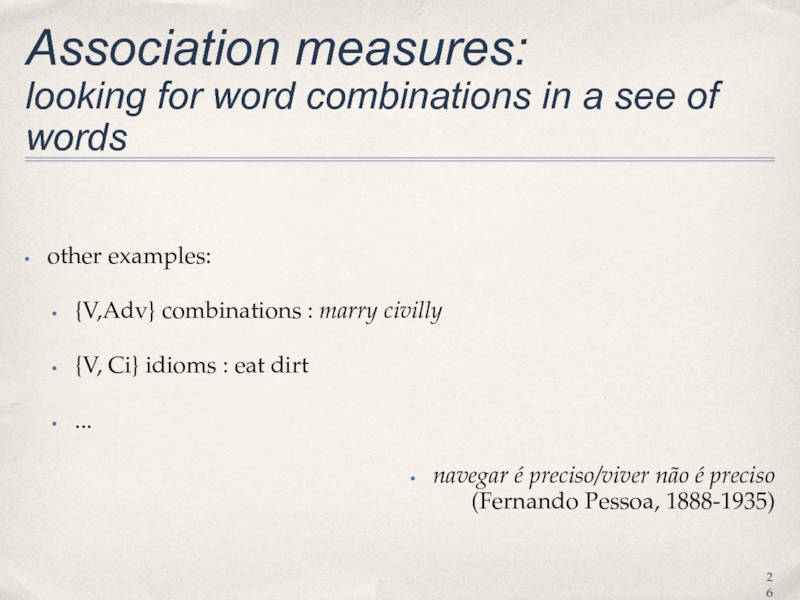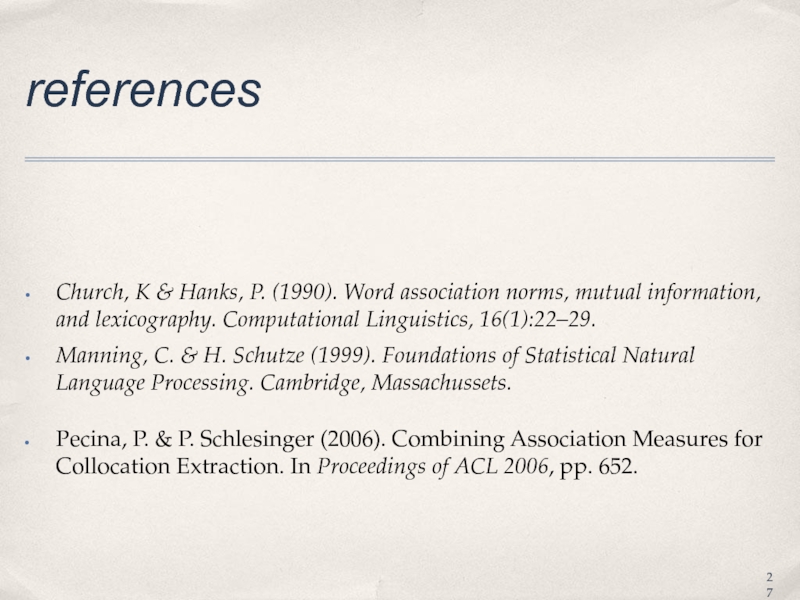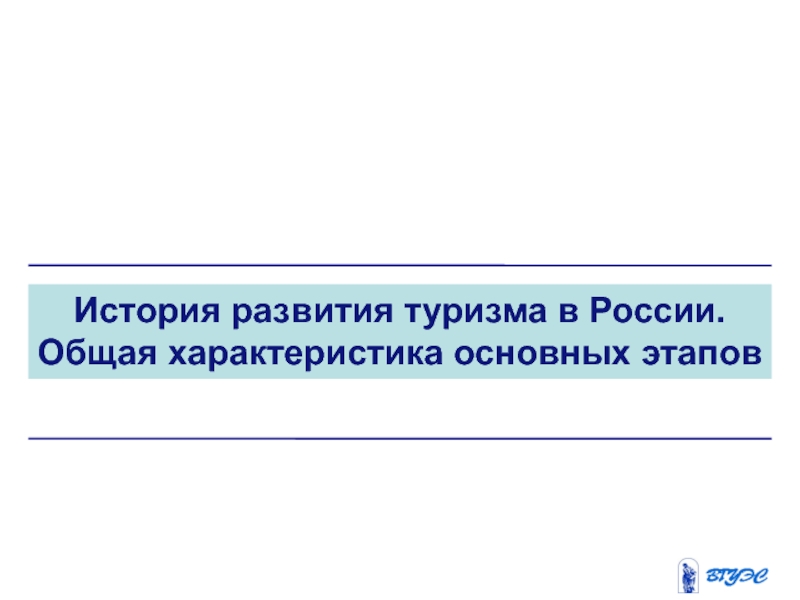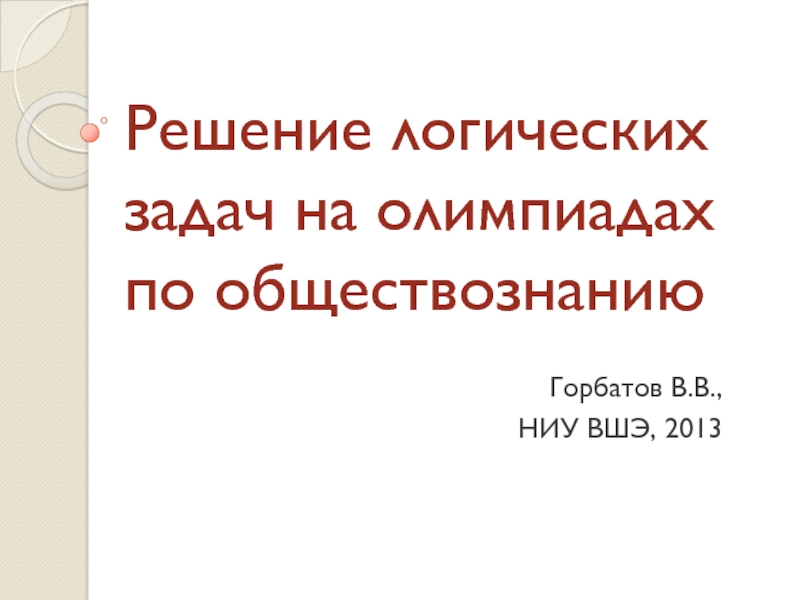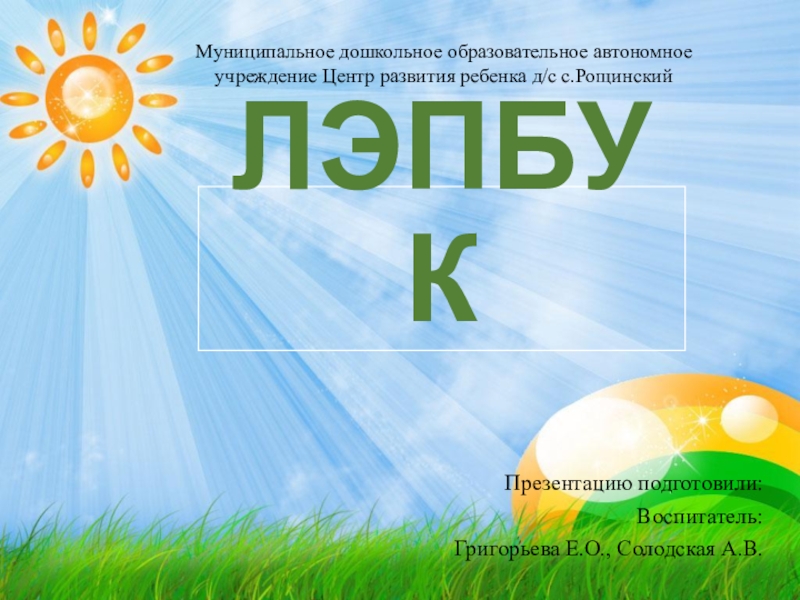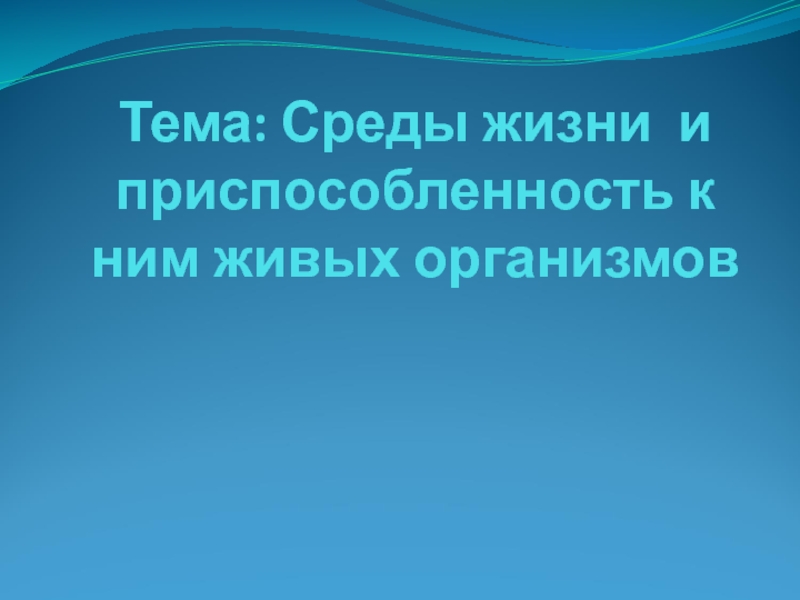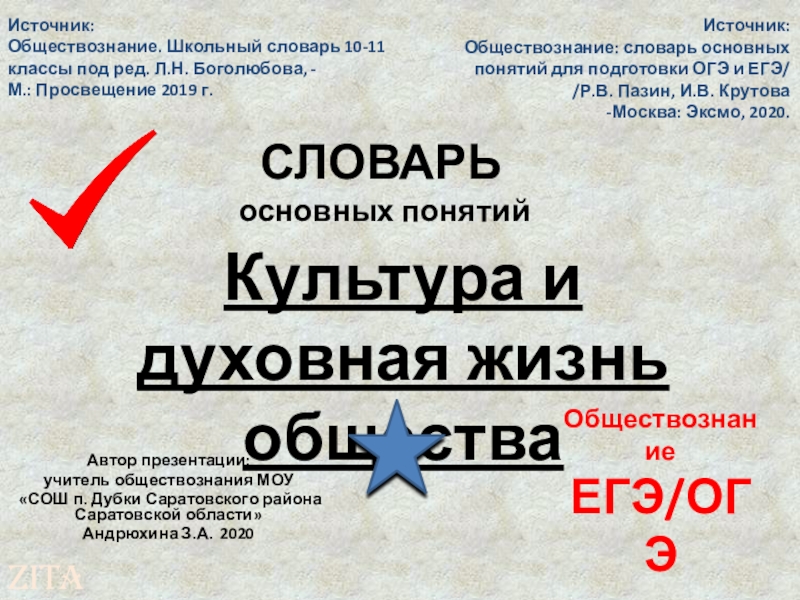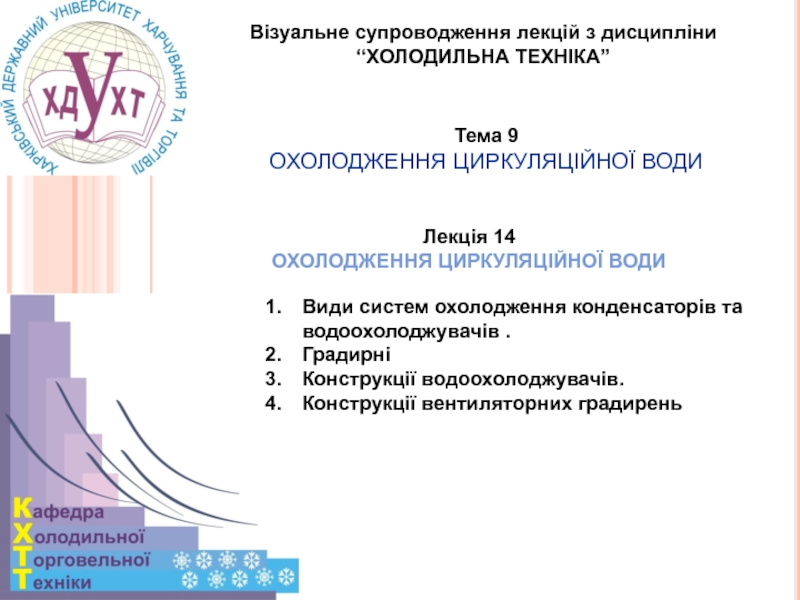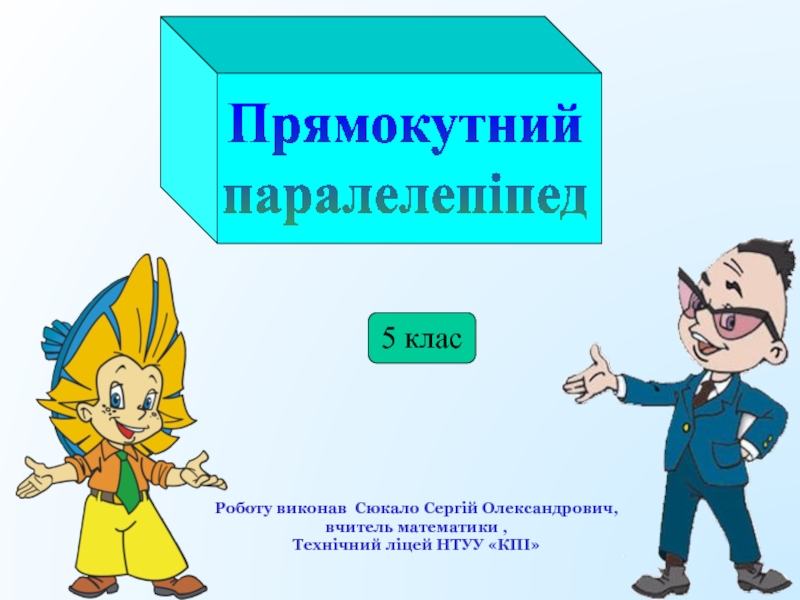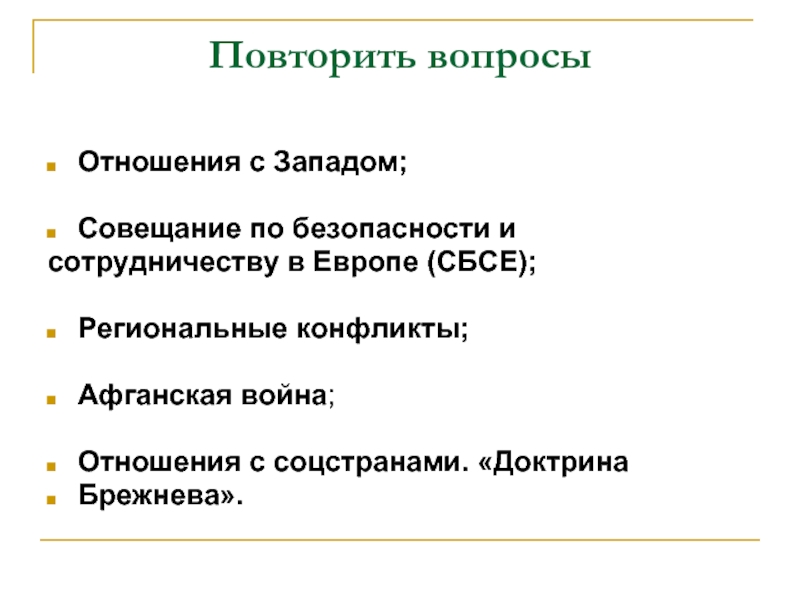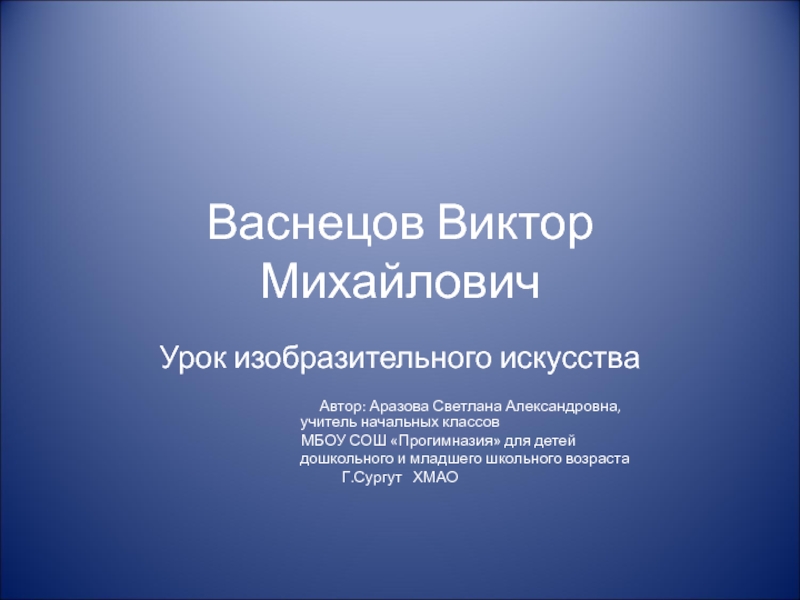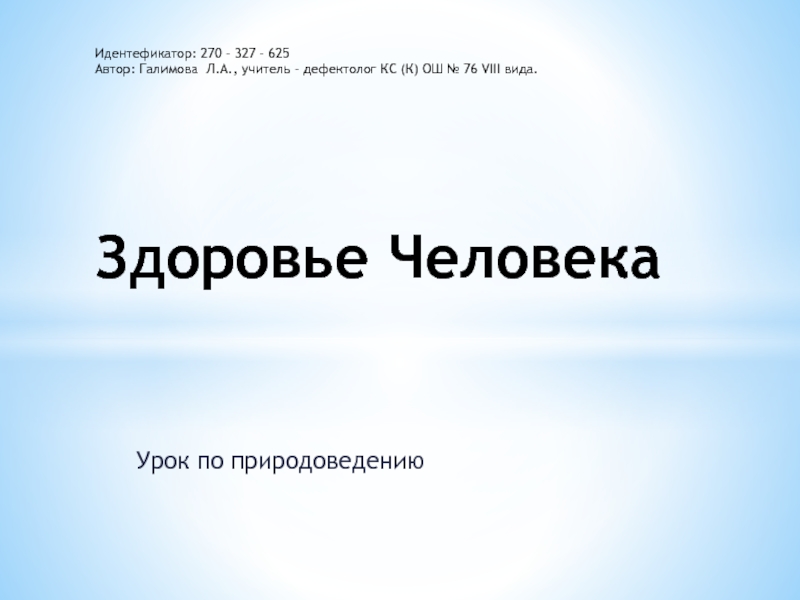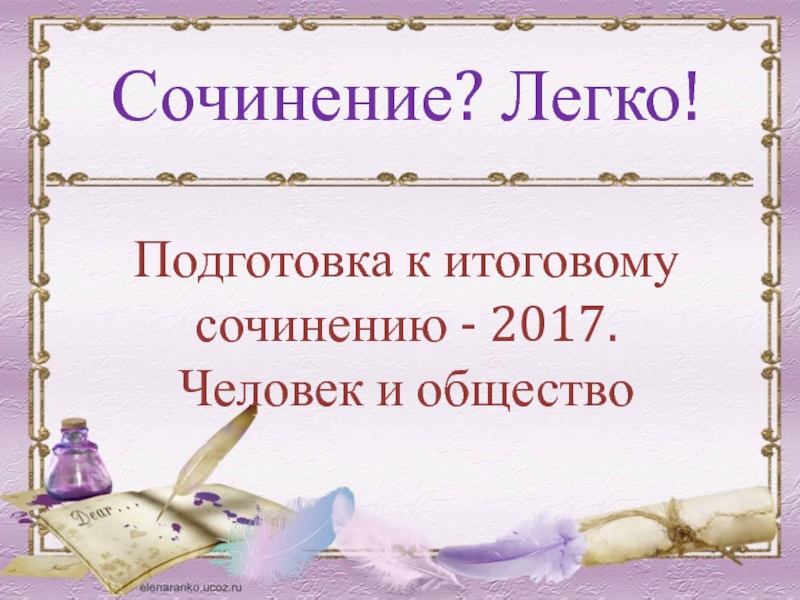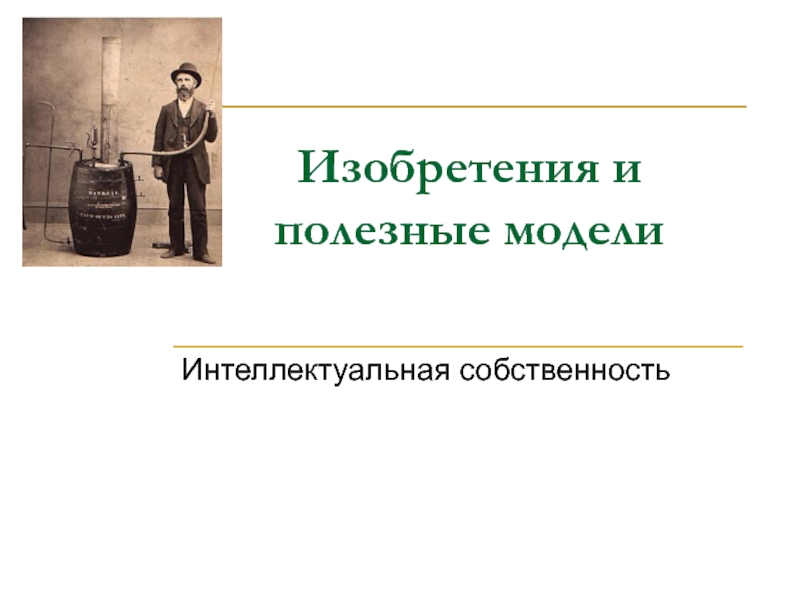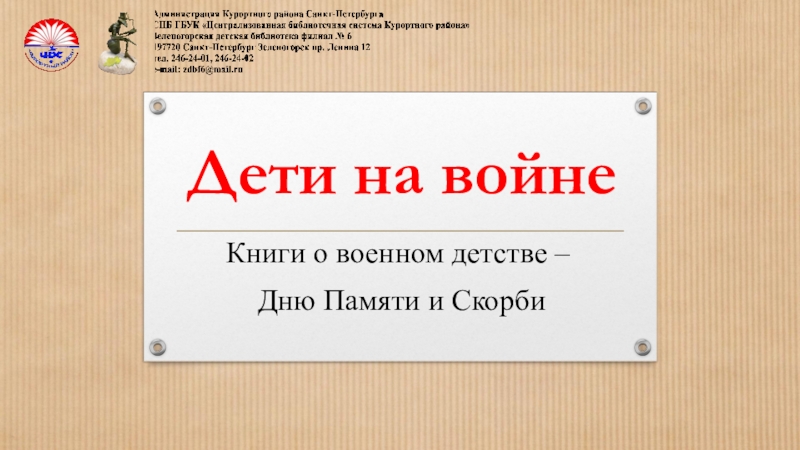Слайд 1Taurida National V. I. Vernadsky University , e-Lecture , March
18, 2014
Association Measures
Discovering idioms in a sea of words
Jorge
Baptista
University of Algarve, Faro, Portugal
Spoken Language Lab, INESC ID Lisboa, Portugal
Слайд 2a definition of idiom
multiword expression: composed of two or more
words
meaning of the overall sequence can not be calculated from
the individual meaning of the component words when used separately
this difference in meaning is related to different formal properties :
combinatorial, morphological, ...
different types of idioms may show different properties
Слайд 3formal types of idioms
noun phrases
noun + adjective (in English adjective+noun)
:
round table, yellow fever, good practices,
noun + preposition
+ noun:
Portuguese man o' war (Physalia physalis),
prepositional phrases :
in a rush, in the spur of the moment, by accident, on purpose
verb + complement : kick the bucket, hold Poss0 tongue,
Слайд 4Dictionaries
are always incomplete...
new words are created every day, to
coin new concepts, ideas, tools, methods, objects...
old words (from every
age) are reshaped either in form or in use
to function as new words, mostly by smoothly changing their environments
no dictionary can ever be up-to-date
but for computer natural language processing NLP,
the lexicon is key to the performance of many tasks
so: we need ways of acquiring lexicon (semi-)automatically,
help lexicographer describe their rapidly evolving object
build resources for NLP
Слайд 5Corpus linguistics
The low cost and easy availability of large-sized corpus
(several hundred million words) makes it possible to study linguistic
phenomena such as idioms, including their lexical acquisition for lexicographic/lexicological purposes
one requires appropriate tools for corpora processing, basically, counting words and words’ combinations
more sophisticated processing (POS taggers and parsers) can help improve the results for certain types of idioms (or are essential to some of them)
Слайд 6Looking for idioms in a sea of words
Frequency is often
a good indicator of an idiom, but can be improved
by POS filters:
Слайд 7Association measures:
looking for word combinations in a see of
words
Association Measures (AM) are statistical methods
that can help linguists’
work in finding statistically relevant
word combinations that may/should be included in the lexicon
as idioms, collocations, etc.
most important AMs for our task are based
on the concept of hypothesis testing :
Student’s t-test (t)
chi-quare (Χ2)
another important measure, based on information theory is
the (pointwise) Mutual Information (PMI or MI)
in the case of relative position of words in word combinations,
the Dice coefficient (D) is also important (eventually, language dependent)
Слайд 9Hypothesis testing
It is a simple statistical concept, that can be
formulated as a question:
Given a pair of events, how likely
is it that they co-occurred by some reason or that it was chance alone?
In our case, let’s think of ‘events’ as words and ‘pair of events’ as word combinations, as in the case of idioms
‘likelihood’ involves the concept of probability
the concept of ‘chance’ is linked to the hypothesis testing setting, where one of the hypothesis is the null hypothesis, where two events co-occur by mere chance
CAVEAT: finding that there must be a reason (and not just mere chance) for a pair of events, does not mean that there is a causal relation between them (problem of the tertium aliquid)
Слайд 10Hypothesis testing (continued)
The strategy of hypothesis testing:
If two events co-occur
by chance alone: null hypothesis
Else, some cause links the events
Though
the cause may be elusive, we can discard the null hypothesis and say that at least that two events did not occur by chance
Слайд 11Hypothesis testing (continued)
Defining a null hypothesis (H0):
a pair of words,
or bigram (w1w2), is a chance event if the probability
of its occurring is significantly less than its actual number of occurrences
What is the probability of a word? or of a bigram?
P(w1) = Count(w1)/N
P(w1) = Count(w2)/N
P(w1w2) = Count(w1w2)/N
where N is the total number of words in a given corpus
Слайд 12Hypothesis testing (continued)
So, how do we calculate H0 , given
a bigram w1w2 ?
H0
= P(w1)*P(w2)
=
C(w1)/N * C(w2)/N
Then what?
Then we need a test of statistical relevance to compare H0 with the actual probability of the bigram P(w1w2).
To do this, we introduce the Student t-test
Слайд 13Student’s t-test
Student’s t-test is an association measure that is represented
by the following formula:
where:
x’ represents the sample mean (i.e. the
bigram probability);
μ is the distribution mean (i.e. the null hypothesis, H0); and
s2 is the sample variance (that we will consider to be same as the sample mean: s2 = x’);
N, as we already know, is the total number of instances
(words in the corpus)
Слайд 14Student’s t-test
looking for data...
Let’s take a look at a
simple noun+adjective combination in Portuguese:
mesa redonda
‘round table’
access freely available corpus:
CETEMPúblico
find the N (total number of words): 191,277,678
find the frequency of each lemma: mesa and redonda
find the frequency of the bigram (lemmas):
mesa redonda
www.linguateca.pt/cetempublico
Слайд 15Student’s t-test
an example
Now we have all the data we
need:
Count(mesa) ‘table’: 16,969
Count(redondo) ‘round’: 1,982
Count(mesa redonda) ‘round table’: 544
Total number
of words, N: 191,277,678 (approx. 191,3 M words)
Let’s make the calculation of the probabilities for w1, w2 and w1w2:
P(mesa) ‘table’: 16,969/191,277,678
= 0,00008871395856 ≈ 8,87e-5
P(redondo) ‘round’: 1,982/191,277,678
= 0,0000103618991 ≈ 1,04e-5
P(mesa redonda) ‘round table’: 544/91,277,678
= 0,00000284403285 ≈ 0,28e-5
Слайд 16Student’s t-test
an example
Based on the previous calculation,
we can
now determine the null hypothesis (H0)
H0 = p(w1)*p(w2) = 8,87e-5
* 1,04e-5 = 9,19e-10 ≈ 0,0000919e-5
Finally, we apply the t-test formula:
t = (x’-n)/√(x’/N)
= (0,28e-5 - 0,0000919e-5)/√(0,28e-5/191,277,678)
= 0,2799077e-5/0,0000001 = 23,31626888
Слайд 17Student’s t-test
an example
Now, we look in a t-test relevance
threshold table:
The degree of certainty/relevance (usually represented by α ‘alpha’)
in NLP is α=0,005, because we deal with large datasets,
while in the human/social sciences is usually higher, α=0,05;
The threshold is usually represented by p.
For a relevance a=0,005, the t-test threshold is p=2,576
if t < p, then we are 99,5% sure that we can not discard the null hypothesis, and the combination is due to chance
if t > p, then we are 99,5% sure that we can discard the null hypothesis and the combination is not due to chance
Слайд 18Student’s t-test
an example
SO, in our example, since t(mesa redonda)
= 27,99077
hence, t > p,
therefore, we can reject the null
hypothesis and say that this word combination is not due to chance
Notice that the linguistic status (a compound noun) can not be determined, just that the combination is not random.
Слайд 19Student’s t-test
conclusion
The Student t-test is an easy way to
determine if two events (words) co-occur by chance alone, or
if their co-occurrence is statistically relevant
however, this AM ignores the marginal distribution of w1 and w2, that is, the cases when they do not co-occur.
A more sophisticated AM is the chi-square (X2)
Слайд 20Chi-square (X2)
The Student t-test assumes a normal distribution of the
probabilities of the events, while the Chi-square does not
compares the
observed frequences of the events with the expected frequences if the events were independent
if the difference is larger than the statistical relevance threshold,
then we can reject the null hypothesis of independence of events
Слайд 22Chi-square
an example
An easier way to do these calculations is to
use a spreadsheet:
Слайд 23Mutual Information
Mutual information is an AM derived from Information Theory,
and is often used in determining idioms and compound words
It
is defined by the following formula:
I can be defined has the amount of information between two events (x and y); the higher the MI, the more likely it is to have y given x (and vice-versa);
it is a good AM to rank candidates to idiom status
but there is no threshold value
it uses the same values we have already calculated:
P(w1), P(w2), P(w1w2) and N
Слайд 24Mutual Information
an example
Based on the previous data about the compound
mesa redonda ‘round table’ lets calculate its MI in the
same corpus:
P(mesa) ‘table’ ≈ 8,87e-5
P(redondo) ‘round’ ≈ 1,04e-5
P(mesa redonda) ‘round table’≈ 0,28e-5
N = 191,277,678
MI(mesa,redonda)
= log2( P(mesa redonda)/(P(mesa)*(P(redonda) ))
= log2(0,28e-5/(8,87e-5 * 1,04e-5))
= 11,59520095
Слайд 25Association measures:
looking for word combinations in a see of
words
Слайд 26Association measures:
looking for word combinations in a see of
words
other examples:
{V,Adv} combinations : marry civilly
{V, Ci} idioms :
eat dirt
...
navegar é preciso/viver não é preciso
(Fernando Pessoa, 1888-1935)
Слайд 27references
Church, K & Hanks, P. (1990). Word association norms, mutual
information, and lexicography. Computational Linguistics, 16(1):22–29.
Manning, C. & H.
Schutze (1999). Foundations of Statistical Natural Language Processing. Cambridge, Massachussets.
Pecina, P. & P. Schlesinger (2006). Combining Association Measures for Collocation Extraction. In Proceedings of ACL 2006, pp. 652.
